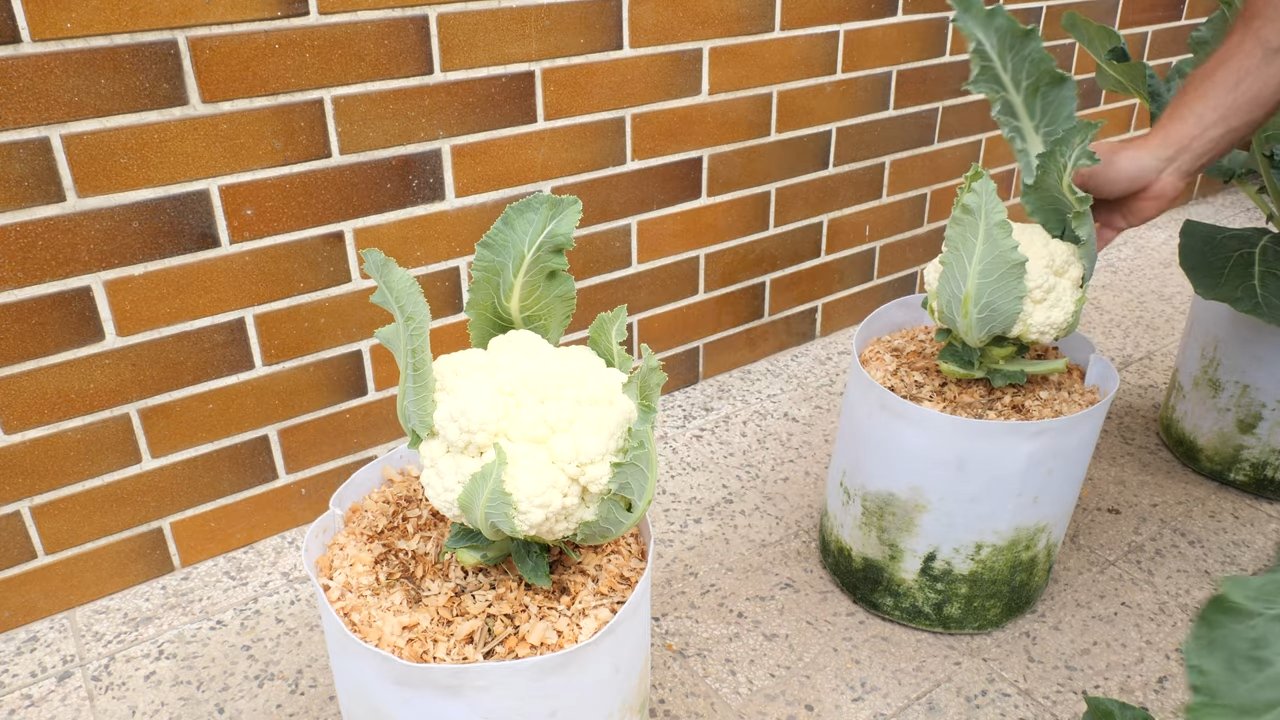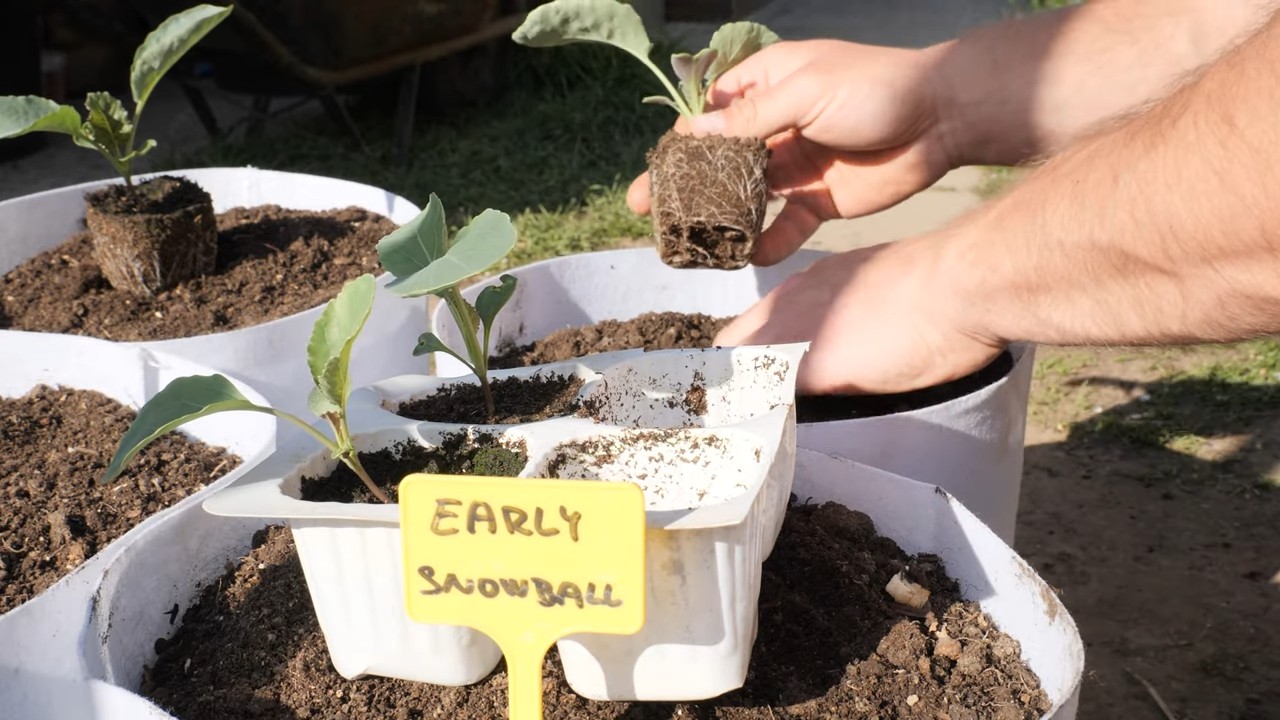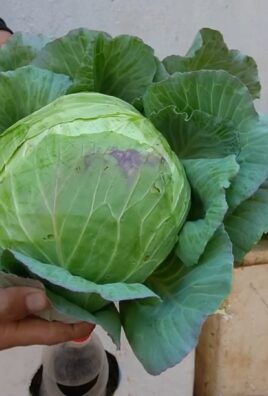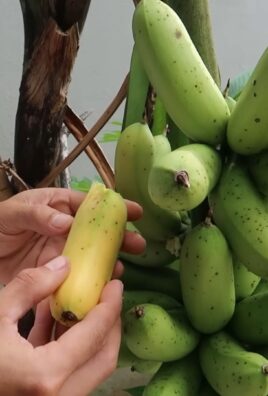Growing Cauliflower at Home might seem daunting, conjuring images of sprawling farms and expert gardeners. But what if I told you that cultivating this nutritious and delicious vegetable is entirely achievable, even in a small backyard or balcony garden? Imagine the satisfaction of harvesting your own, perfectly formed cauliflower head, knowing exactly where it came from and what went into its growth – a far cry from the often-bland supermarket variety!
Cauliflower, a member of the Brassica family, has a rich history dating back to ancient times. Originating in the Mediterranean region, it was prized for its unique flavor and health benefits. Over centuries, it has spread across the globe, becoming a staple in diverse cuisines. But somewhere along the way, the connection to its natural origins has been lost for many of us. That’s where this DIY guide comes in!
In today’s world, where we’re increasingly conscious of food miles and the impact of industrial agriculture, growing cauliflower at home offers a fantastic way to reconnect with nature and enjoy fresh, healthy produce. This article is packed with simple, effective DIY tricks and hacks that will empower you to successfully cultivate cauliflower, regardless of your gardening experience. We’ll cover everything from seed starting and soil preparation to pest control and harvesting, ensuring you have all the knowledge you need to enjoy a bountiful cauliflower harvest. So, let’s ditch the grocery store and get our hands dirty!

Growing Cauliflower at Home: A Beginner’s Guide
Hey there, fellow garden enthusiasts! Ever dreamt of harvesting your own crisp, delicious cauliflower right from your backyard? Well, dream no more! Growing cauliflower might seem intimidating, but trust me, with a little patience and the right know-how, you can absolutely do it. I’m here to guide you through the entire process, from seed to harvest. Let’s get our hands dirty!
Choosing the Right Cauliflower Variety
First things first, let’s talk about cauliflower varieties. There’s a whole world beyond the standard white cauliflower you see in the grocery store. Consider these options:
* Snowball: A classic, reliable white variety, perfect for beginners. It matures relatively quickly.
* Cheddar: This one’s a showstopper! It produces beautiful orange heads, packed with extra beta-carotene.
* Graffiti: Want to add some color to your garden? Graffiti cauliflower boasts vibrant purple heads.
* Romanesco: This variety is not only delicious but also visually stunning, with its fractal-like, lime-green heads.
Think about your climate and growing season when making your choice. Some varieties are better suited for warmer or cooler weather. Check the seed packet for specific recommendations.
Starting Your Cauliflower Journey: Seeds or Transplants?
You have two main options for starting your cauliflower: seeds or transplants.
* Seeds: Starting from seed gives you more control over the entire process and allows you to choose from a wider variety of options. However, it requires more time and attention.
* Transplants: Buying transplants from a local nursery is a convenient option, especially if you’re short on time or space. Just make sure the transplants look healthy and vigorous, with no signs of pests or diseases.
I personally prefer starting from seed because I love watching the little seedlings emerge and grow. But either way works!
Starting Cauliflower from Seed (My Preferred Method!)
If you’re like me and want to start from seed, here’s what you need to do:
1. Timing is Key: Cauliflower needs a long growing season, so start your seeds indoors about 4-6 weeks before the last expected frost in your area. Check your local frost dates to be sure.
2. Gather Your Supplies: You’ll need:
* Seed starting trays or small pots
* Seed starting mix (a light, well-draining mix is essential)
* Cauliflower seeds (of course!)
* A spray bottle filled with water
* A heat mat (optional, but helpful for germination)
* A grow light (also optional, but highly recommended)
3. Sowing the Seeds:
* Moisten the seed starting mix thoroughly.
* Fill the trays or pots with the moistened mix.
* Make a small indentation (about 1/4 inch deep) in the center of each cell or pot.
* Place 2-3 cauliflower seeds in each indentation.
* Gently cover the seeds with more seed starting mix.
* Lightly mist the surface with water.
4. Creating the Ideal Germination Environment:
* Place the trays or pots on a heat mat (if using) and cover them with a humidity dome or plastic wrap to retain moisture.
* Keep the soil consistently moist but not soggy.
* Once the seeds germinate (usually within 5-10 days), remove the humidity dome or plastic wrap.
* Place the seedlings under a grow light (if using) or in a sunny window.
5. Caring for the Seedlings:
* Water the seedlings regularly, allowing the soil to dry out slightly between waterings.
* Thin the seedlings to one plant per cell or pot once they have their first true leaves (the leaves that look like miniature cauliflower leaves). Snip off the weaker seedlings at the soil line.
* Fertilize the seedlings with a diluted liquid fertilizer (follow the instructions on the fertilizer label) every 1-2 weeks.
* Harden off the seedlings before transplanting them outdoors. This means gradually exposing them to outdoor conditions over a period of 7-10 days. Start by placing them in a sheltered location for a few hours each day, gradually increasing the amount of time they spend outdoors.
Transplanting Your Cauliflower Seedlings (or Store-Bought Transplants)
Once your seedlings are hardened off (or you’ve purchased transplants), it’s time to get them in the ground!
1. Choosing the Right Location: Cauliflower needs at least 6 hours of sunlight per day. Choose a location with well-drained soil that is rich in organic matter.
2. Preparing the Soil:
* Amend the soil with compost or well-rotted manure to improve drainage and fertility.
* Cauliflower prefers a slightly acidic soil pH (around 6.0-6.5). You can test your soil pH with a soil testing kit and amend it accordingly.
3. Planting the Seedlings:
* Space the seedlings about 18-24 inches apart in rows that are 24-36 inches apart.
* Dig a hole that is slightly larger than the root ball of the seedling.
* Gently remove the seedling from its pot and loosen the roots slightly.
* Place the seedling in the hole and backfill with soil, gently firming the soil around the base of the plant.
* Water the seedlings thoroughly.
4. Protecting Your Plants:
* Cover the seedlings with row covers to protect them from pests and cold weather.
* Mulch around the plants with straw or wood chips to help retain moisture and suppress weeds.
Caring for Your Growing Cauliflower
Now that your cauliflower is in the ground, it’s time to provide it with the care it needs to thrive.
1. Watering: Cauliflower needs consistent moisture, especially during head formation. Water deeply and regularly, especially during dry spells. Aim for about 1-2 inches of water per week.
2. Fertilizing: Feed your cauliflower plants every 2-3 weeks with a balanced fertilizer. You can also side-dress them with compost or well-rotted manure.
3. Weeding: Keep the area around your cauliflower plants free of weeds. Weeds compete with cauliflower for nutrients and water.
4. Pest Control: Keep an eye out for common cauliflower pests, such as cabbage worms, aphids, and flea beetles. Handpick pests off the plants or use organic pest control methods, such as insecticidal soap or neem oil.
5. Blanching (for White Varieties): To keep white cauliflower heads from turning yellow, you’ll need to blanch them. When the head is about 2-3 inches in diameter, fold the outer leaves over the head and secure them with twine or rubber bands. This will block sunlight and keep the head white. Colored varieties don’t need blanching.
Harvesting Your Cauliflower
The moment we’ve all been waiting for! Harvesting your own cauliflower is incredibly rewarding.
1. Timing is Everything: Cauliflower is ready to harvest when the head is firm, compact, and reaches the desired size (usually 6-8 inches in diameter).
2. Harvesting Technique: Use a sharp knife to cut the head from the plant, leaving a few leaves attached to protect the head.
3. Storage: Store harvested cauliflower in the refrigerator for up to a week.
Troubleshooting Common Cauliflower Problems
Even with the best care, you might encounter some problems along the way. Here are a few common issues and how to address them:
* Buttoning (small heads): This can be caused by stress, such as lack of water or nutrients, or extreme temperature fluctuations. Make sure your plants are getting enough water and fertilizer, and protect them from extreme weather.
* Loose Heads: This can be caused by hot weather or inconsistent watering. Provide shade during the hottest part of the day and water regularly.
* Yellowing Heads: This is usually caused by sunlight exposure. Blanch white varieties to prevent yellowing.
* Pest Infestations: Regularly inspect your plants for pests and take action promptly.
Enjoying Your Homegrown Cauliflower
Congratulations! You’ve successfully grown your own cauliflower. Now it’s time to enjoy the fruits (or rather, vegetables) of your labor. Cauliflower is incredibly versatile and can be used in a variety of dishes, from roasted cauliflower to cauliflower rice to creamy cauliflower soup. Get creative and experiment with different recipes!
Growing cauliflower at home is a rewarding experience that allows you to enjoy fresh, delicious produce while connecting with nature. Don’t be afraid to give it a try – you might just surprise yourself with your green thumb! Happy gardening!

Conclusion
So, there you have it! Growing cauliflower at home, while it might seem daunting at first, is an incredibly rewarding experience that puts fresh, flavorful, and nutritious produce right at your fingertips. We’ve walked you through the essential steps, from selecting the right variety and preparing your soil to nurturing your plants and protecting them from pests and diseases. The satisfaction of harvesting your own perfectly formed cauliflower head, knowing exactly where it came from and how it was grown, is simply unmatched.
But why is this DIY trick a must-try? Beyond the sheer joy of gardening, growing your own cauliflower offers several compelling advantages. Firstly, you gain complete control over the growing process, ensuring that your cauliflower is free from harmful pesticides and herbicides. This is especially important for those seeking organic and sustainable food options. Secondly, homegrown cauliflower often boasts a superior flavor compared to store-bought varieties. The freshness and lack of transportation time allow the natural sweetness and subtle nutty notes to truly shine. Finally, growing cauliflower at home can be a significant cost-saver, especially if you consume cauliflower regularly.
Don’t be afraid to experiment with different varieties to find your personal favorite. Consider trying colorful options like purple or orange cauliflower for a visually stunning addition to your garden and your plate. You can also explore different planting times to extend your harvest season. For example, planting a succession of cauliflower seedlings every few weeks will ensure a continuous supply throughout the growing season.
Furthermore, consider companion planting to enhance the health and productivity of your cauliflower plants. Marigolds, for instance, can help deter pests, while herbs like rosemary and thyme can attract beneficial insects.
We understand that gardening can sometimes be challenging, and you might encounter a few hiccups along the way. But don’t let that discourage you! Every gardening experience is a learning opportunity, and with a little patience and perseverance, you’ll be harvesting beautiful cauliflower heads in no time.
We wholeheartedly encourage you to give this DIY trick a try. Embrace the process, learn from your mistakes, and most importantly, have fun! And once you’ve harvested your first homegrown cauliflower, we’d love to hear about your experience. Share your tips, successes, and challenges in the comments below. Let’s build a community of home gardeners and inspire each other to grow our own food. Remember, the journey of a thousand miles begins with a single seed, and the journey to delicious, homegrown cauliflower begins with you! So, grab your gardening gloves, prepare your soil, and get ready to experience the joy of growing your own cauliflower at home. You won’t regret it!
Frequently Asked Questions (FAQ)
Q: What is the best time of year to start growing cauliflower?
A: The best time to start growing cauliflower depends on your climate. Cauliflower thrives in cool weather, so it’s generally best to plant it in the spring or fall. For a spring crop, start seeds indoors 6-8 weeks before the last expected frost. For a fall crop, start seeds indoors in mid-summer or direct sow them in late summer. In warmer climates, you can grow cauliflower throughout the winter. Pay attention to your local weather patterns and adjust your planting schedule accordingly.
Q: What kind of soil is best for growing cauliflower?
A: Cauliflower prefers well-drained, fertile soil that is rich in organic matter. The ideal soil pH is between 6.0 and 7.0. Before planting, amend your soil with compost or well-rotted manure to improve its fertility and drainage. You can also add a slow-release fertilizer to provide essential nutrients throughout the growing season. Avoid planting cauliflower in heavy clay soil, as this can lead to root rot. If you have clay soil, amend it with plenty of organic matter to improve its drainage.
Q: How much sunlight does cauliflower need?
A: Cauliflower needs at least 6 hours of direct sunlight per day to thrive. Choose a planting location that receives plenty of sunlight throughout the day. If you live in a hot climate, provide some afternoon shade to protect your cauliflower plants from scorching. Insufficient sunlight can result in small, poorly formed heads.
Q: How often should I water my cauliflower plants?
A: Cauliflower plants need consistent moisture to grow properly. Water deeply and regularly, especially during dry periods. Aim to keep the soil consistently moist but not waterlogged. A good rule of thumb is to water when the top inch of soil feels dry to the touch. Mulching around your cauliflower plants can help retain moisture and suppress weeds.
Q: What are some common pests and diseases that affect cauliflower?
A: Cauliflower is susceptible to several pests and diseases, including cabbage worms, aphids, flea beetles, clubroot, and black rot. To prevent pest and disease problems, practice good garden hygiene, such as removing plant debris and weeds. Inspect your plants regularly for signs of pests or diseases and take action promptly. Use organic pest control methods, such as insecticidal soap or neem oil, to control pests. Choose disease-resistant varieties of cauliflower to minimize the risk of disease.
Q: How do I know when my cauliflower is ready to harvest?
A: Cauliflower is ready to harvest when the head is firm, compact, and reaches the desired size. The size of the head will vary depending on the variety, but most varieties are ready to harvest when the head is 6-8 inches in diameter. The florets should be tightly packed together and free from blemishes. Use a sharp knife to cut the head from the plant, leaving a few leaves attached to protect the head.
Q: Can I grow cauliflower in containers?
A: Yes, you can grow cauliflower in containers, but you’ll need to choose a large container that is at least 12 inches in diameter and 12 inches deep. Use a high-quality potting mix and provide regular watering and fertilization. Container-grown cauliflower may require more frequent watering than plants grown in the ground. Choose a compact variety of cauliflower that is well-suited for container gardening.
Q: What can I do if my cauliflower head is loose or not forming properly?
A: There are several reasons why your cauliflower head might be loose or not forming properly. Insufficient sunlight, lack of nutrients, inconsistent watering, or extreme temperatures can all contribute to this problem. Ensure that your cauliflower plants are receiving at least 6 hours of direct sunlight per day, fertilize them regularly with a balanced fertilizer, and water them consistently. Protect your plants from extreme temperatures by providing shade during hot weather and covering them during cold weather.
Q: How can I prevent my cauliflower from turning yellow?
A: Cauliflower heads can turn yellow if they are exposed to too much sunlight. To prevent this, blanch the heads by tying the outer leaves together over the developing head when it reaches about 3 inches in diameter. This will protect the head from the sun and keep it white. You can also purchase self-blanching varieties of cauliflower that naturally curl their leaves over the head.
Q: Can I eat the leaves of the cauliflower plant?
A: Yes, the leaves of the cauliflower plant are edible and nutritious. They can be cooked like other leafy greens, such as kale or collard greens. The leaves are a good source of vitamins, minerals, and fiber.




Leave a Comment